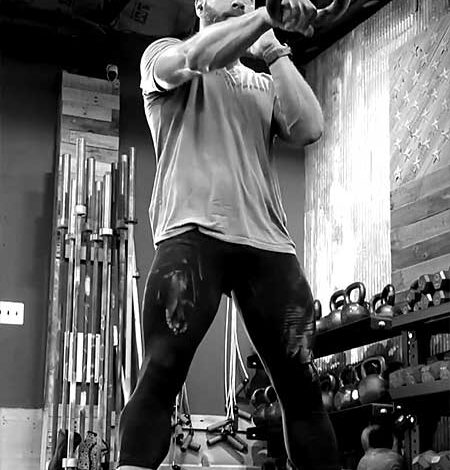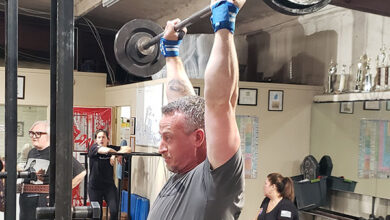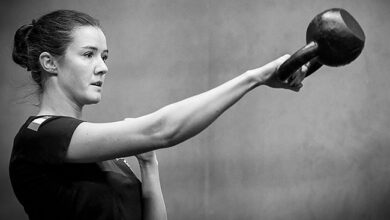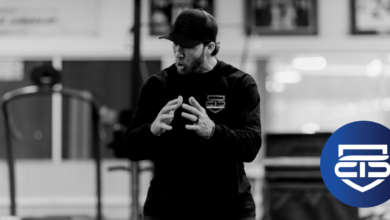How I Trained for Super Sinister

In my previous article, “Introducing Super Sinister,” I introduced a new challenge for Sinister athletes. Classic Sinister requires you to perform 10 one-arm swings (48kg for men/32kg for women) every 30 seconds for 5 minutes, totaling 100 swings. Then after one minute of rest, you perform one get-up (48kg for men/24kg for women) every minute for 10 minutes.
Super Sinister, like Classic Sinister, requires 100 one-arm swings and 10 get-ups, using the same weight as Classic Sinister; however, it is performed more quickly. In Super Sinister, you must perform the 100 one-arm swings unbroken. You have 3 minutes to complete the swings, which for most takes around 2 minutes and 40 seconds. Second, instead of a one-minute rest, you will only have the remainder of the allotted 3 minutes for your swings before you start your get-ups. Best case scenario, you will have around 20 seconds of rest. Just enough time to towel off and lay on the floor. Finally, instead of performing the get-ups at a pace of one rep each minute, you will have to maintain a pace of one rep every 30 seconds (5 minutes total). Most experienced kettlebell athletes execute a controlled, safe, and clean get-up in about 20 seconds. Performing one rep every 20 seconds will only provide 10 seconds of rest between get-ups instead of the 40 seconds provided in Classic Sinister.

As you can imagine, the Super Sinister challenge is going to push you in completely different ways than Classic Sinister. The ability to cleanly execute Classic Sinister, on a consistent basis, is a pre-requisite for attempting Super Sinister—quite the high bar. While Classic Sinister tests your power and strength, Super Sinister challenges both your work and metabolic capacities. No doubt, performing 100 one-arm swings broken into sets of 10, as one does in Classic Sinister, is metabolically challenging; however, performing 100 one-arm swings unbroken is metabolically challenging on a completely different level. You can expect to hit ≥98% of your max heart rate (MHR) during the test. This is higher than you would likely hit in Classic Sinister, which for most of you, would be somewhere between 88% and 92% of your MHR. That may not sound like a big difference, but when you are in the middle of 100 unbroken one-arm swings and your heart rate (HR) is pushing 100%, it is almost nauseating…and then you start your get-ups.
Here we must be careful. Get-ups are a wonderful exercise, but they come with a risk of injury. Put bluntly, they are potentially lethal. This is why we don’t typically advise performing get-ups quickly or under high levels of fatigue. For Super Sinister, you will have to violate both safety guidelines. When you get under your first get-up, your HR will be pushing 95% and by the time you get under that last get-up, your fatigue level will be extreme.
Take your time and always follow the Golden Rule of get-ups:
Never attempt a get-up you are not confident you can safely complete.
Before diving into the program, it’s important to acknowledge that pushing yourself as hard as is required for Super Sinister carries some risk. You need to be careful.
For context, before the thought of training for Super Sinister ever popped into my head, I had been seriously training for Sinister for nearly two years and had maintained “Sinister Shape” for six months, during which time I executed a clean Sinister more than thirty times. I was very comfortable with swinging heavy kettlebells and had pushed my HR well above 90% of my MHR on many occasions. Because of the dangers involved with high intensity anaerobic training and performing get-ups under considerable fatigue, I advise that you maintain “Sinister Shape” (meaning you could perform a passing Sinister at any time) for no less than six months before you start training for Super Sinister. This will give your body the necessary time it needs to adapt before you push it to the next level.
The Program
While the program I used to train for Classic Sinister was more complex, I kept things simple (pun not intended) for Super Sinister. I began by completing 100 unbroken one-arm swings once a week. I started with a 24kg kettlebell and worked up to the 40kg. When I got to the 40kg, my progress slowed down and I needed to increase the dose and add more metabolic work to get to the finish line. I followed the plan outlined in Table 1 below for the final push to Super Sinister, using the 44kg and 48kg kettlebells, which took about 4 months.

Zone 2 Work
Swings, get-ups, and strength work are normal items to see on a StrongFirst athlete’s training split. What one normally does not see, however, is aerobic work—specifically easy Zone 2 work. Zone 2 work (“cardio” as it is often called) is frequently said with an eye roll and typically not practiced by strength athletes in general. The common argument holds that it is boring or a waste of time. True, Zone 2 work most certainly can be time-consuming, but that doesn’t mean it has no value.
Remember, Classic Sinister is a test of strength. Super Sinister is a test of capacity. In Classic Sinister, athletes typically hit right around 90% of their MHR during swings, but their HR drops dramatically during the get-ups. This is not the case in Super Sinister. In Super Sinister, most of you will hit well above 90% of your MHR during swings and will stay at 80-85% of your MHR for the duration of your get-ups. Simply stated, the metabolic demand in Super Sinister is dramatically higher than it is for Classic Sinister. It is for this reason that I advise adding 2-4 hours of easy Zone 2 work to your training. This will help build the critical aerobic base necessary to successfully complete Super Sinister.
No matter the activity—whether it’s walking 100 miles at a slow pace or hitting a max single in the snatch—all energy for movement is produced through a combination of three energy systems: ATP-PC, anaerobic, and aerobic. Zone 2 work is performed at a pace where most of the energy produced comes from aerobic metabolism. It is the pace at which the aerobic system is maximally stressed. Aerobic metabolism is the energy system best suited for long bouts of activity, such as century cycling, as well as everyday movements like grocery shopping or walking your dog. It is the foundation of all metabolism. Having a strong “aerobic base” is not only good for longevity and health in general, but it will also help you meet the metabolic demands of Super Sinister.

While Zone 2 pacing calculations can be highly specific (a pace at which one maintains a blood lactate concentration of 1.7-1.9 mmol/L), one doesn’t need a lactate meter to effectively do Zone 2 work. For most people, using the equation created by Dr. Phil Maffetone will do just fine. Dr. Phil Maffetone is a pioneer in the fitness and performance industries, often credited with the concept of the “aerobic base.” He has been promoting the importance of easy aerobic work since the 1970s. His equation for finding the best HR to train your aerobic system, called Maximal Aerobic Function (MAF), is 180 minus your age. I have a lactate meter, and this equation is disturbingly accurate. My advice is to do all your Zone 2 work at a pace that keeps your heart rate within five beats of that number.
If you don’t have a heart rate monitor and are uninterested in getting one, you will want to keep your effort at a pace where you can hold a conversation but find it challenging to do so. At the proper pace, you should be able to hold a conversation on the phone, but the person on the other end would still notice that you’re exercising. It may seem counterintuitive, but it is quite accurate.
The most challenging thing for a StrongFirst athlete trying to implement Zone 2 training is that the pace may feel too easy. You will not hop off the stationary bike with the super high you get after a hard anaerobic workout or when you hit a new one rep max in the weight room. None-the-less, easy aerobic work is highly valuable, particularly if you are training for something as metabolically demanding as Super Sinister.
The Swings
The swing progression is not complex, but it does require some patience. Start with a kettlebell you can one-arm swing without difficulty or injury for 100 unbroken reps, switching hands every 10 reps. Do this twice a week until you feel confident you can move up a kettlebell. I advise you to complete three training sessions where you feel you could move up before you actually do. This will ensure that your body truly is ready to progress.
For lighter kettlebells, you can follow this progression exactly as described. For heavier kettlebells (you will know when you get there), I advise you to work up to 120 unbroken one-arm swings with a given kettlebell before you move up in weight. Once you feel “good” doing 100 unbroken one-arm swings, progress to 110 reps and eventually to 120 reps. Once you hit three sessions with a given kettlebell for 120 unbroken one-arm swings, you can jump up to the next kettlebell. I used this progression for the 40kg, the 44kg, and the 48kg kettlebells. Completing 120 unbroken swings is a significant volume, but this level of effort ensures your body adapts effectively and progresses at a safe pace.
The Get-ups
Much like the swing progression, I kept it simple for the get-ups, except for one caveat (see below). Hopefully, when you start on this path towards Super Sinister, you will have been in “Sinister Shape” for no less than six months, which means executing clean get-ups with a 48kg or 24kg kettlebell at a pace of one rep each minute will be relatively easy. Before speeding up the pace, you should confidently be able to complete 15 get-ups at a rate of one rep per minute. Once you’re able to do this, you will cut 5 seconds off of each round. For example, you will go from one rep per minute to one rep every 55 seconds. Train at that pace until you feel ready to shave off another 5 seconds. Continue this progression until you can pull off 15 rounds of clean get-ups at a pace of one rep every 30 seconds. Remember to take your time. Listen to your body and always follow the golden rule of get-ups.
Now for the caveat…
Super Sinister tests capacity and requires a huge metabolic demand. When you start your path towards Super Sinister, you will already have the strength to do the get-ups but will not likely have the capacity to do them at the required pace (that is…unless you are Jackie Vasquez). This means no more get-ups with generous rest and a low HR. From now on, all your get-ups will be done with an elevated HR.
To make sure that you are adequately fit for the get-ups and comfortable performing them with a disturbingly high HR, you will precede every get-up session with 5 minutes on the rower or the air bike (e.g., Assault Bike). Work up to a pace where your HR is just above 90% of your MHR when you finish the 5-minute effort. You need to be careful here. Performing heavy get-ups comes with more than a little danger; doing so under high levels of fatigue increases this risk exponentially. You need to be smart and progress slowly so that you don’t get injured. Start at a pace that you think will be a little challenging. Take note of your HR and adjust the pace accordingly. It may take you several weeks to work up to a pace at which you hit 90% of your MHR and then be able to confidently roll right into the get-ups without any rest. Take your time.

Again, if you don’t have a heart rate monitor, you should exercise at a pace where the voice in your head telling you to stop becomes increasingly loud and hard to ignore. At this effort level, you should be confident that you could hold the pace for an additional 30 seconds, but not so sure that you could hold it for another 60 seconds.
Similar to the aerobic work, this may not seem necessary, but it is critical to mission. You don’t have to crush yourself on the rower before the get-ups, but it is extremely important that you are comfortable and capable of performing heavy get-ups with a considerably elevated HR.
Anaerobic Intervals
Now, for the fun part. To make sure you are metabolically fit enough to pull off 100 unbroken one-arm swings with a 48kg/32kg kettlebell, you will need to push yourself. Once a week you will do repeat anaerobic intervals following your swing session. This will, without a doubt, be your most challenging day of the week.
In Super Sinister, you have 3 minutes to complete your unbroken one-arm swings and rest before you start your get-ups. This means you need to be in tremendous shape for 3-minute metabolic efforts. To prepare for this, you will do repeat anaerobic sessions on the equipment of your choosing after your swing session. (I would suggest either the C2 Rower or an air bike.) Because of the time domain for Super Sinister, you will be doing 3-minute anaerobic efforts with 3 minutes rest. This will start exactly 3 minutes after your swings. Set a pace that pushes your heart rate to 90–95% of your MHR each round, aiming to complete 4–5 rounds.
If you don’t have a heart rate monitor, experiment with a pace that allows you to complete 4–5 rounds and leaves you pretty gassed by the end. If you are completely fried after 3 rounds or have lots more in the tank after the fifth round, then you need to modify the pace accordingly. Once you find the correct pace (500m split on the rower or RPMs/Watts on the air bike), you will stay there until you can hammer out 5 rounds and feel like you’ve got a little more in the tank. Once you consistently feel good after 5 rounds, increase the pace (-2 seconds/500m on the rower or +1 RPM on the air bike).
For most of your Super Sinister training, I advise you call it a day when you are confident that you could hit one more round, but not quite sure you could hit two. However, towards the end of your Super Sinister journey, say once you start using the 48kg/32kg kettlebell for swings, it will be necessary to push to full fatigue. At this intensity, still aim to complete 4–5 rounds, but by the end of the final round, you should feel certain that another round wouldn’t be possible.
Super Sinister will push you to an extreme level. It’s crucial to expose both your body and mind to this environment beforehand to ensure you can handle it safely. You cannot reasonably maintain this intensity without consequences (loss of sleep, injury, poor focus, etc.) for longer than 6-12 weeks. Therefore, you will not push to complete fatigue until the final stretch of your program. A lot of you reading this article may love this kind of training, but please follow the program so you can get through this nasty challenge unscathed.
Strength Work
As you can see in Table 1, I have two days dedicated to strength work. For me, I used these days to train for Beast Tamer and pump iron with my wife. You can use these days however you see fit so long as it does not detract from your Super Sinister training. Do some classic strength training or use these days to rest. It is entirely up to you.
Final Thoughts
There you have it. This is the program I used to successfully execute what we now call Super Sinister. In addition to this program, I made some critical mechanical changes to my swing for Super Sinister, which I will cover in a subsequent article. Be on the lookout for that in early 2025.
If you plan to achieve Sinister someday, or perhaps already have, and you’re looking for the next challenge, Super Sinister will undoubtedly push you to levels you never thought possible. Be smart, listen to your body, and enjoy the journey.

Kettlebell Simple & Sinister
World’s #1 kettlebell program for beginners and beyond




